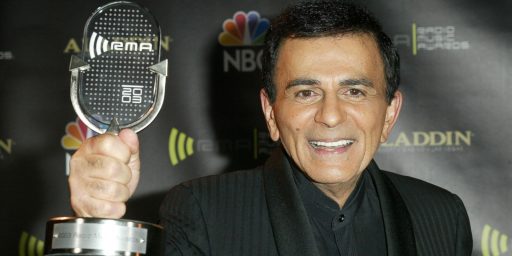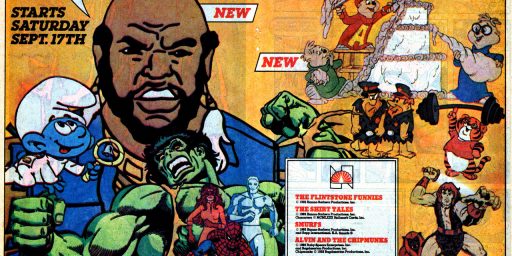Scooby Doo Mystery
Chris Suellentrop explores the baffling mystery of Scooby Doo’s enduring success:
Here’s the easiest way to comprehend the longevity of Scooby-Doo: Casey Kasem has been doing the voice of Shaggy (Norville Rogers, if you insist on his given name) for longer than he hosted his weekly Top 40 radio show. He started voicing Shaggy in 1969, the year before American Top 40 debuted, and he’s still got the part, on television in the WB’s Saturday-morning cartoon, What’s New Scooby-Doo?, and in the direct-to-video movies the franchise keeps churning out.
Though it’s hard to believe—and for animation purists, practically impossible to stomach—Scooby-Doo is the most enduringly popular cartoon in TV history. Starting with the original Scooby-Doo, Where Are You!, the show, in various permutations, was produced for 17 years (and, with its latest incarnation, it’s in production again), making it the longest-running network cartoon ever. Because of syndication, it’s never been off the air since it debuted, and it probably never will be. Now it’s expanding its empire: Scooby-Doo 2: Monsters Unleashed opens today in theaters nationwide, the second of what promise to be many live-action Scooby movies. In 2002, the live-action Scooby-Doo raked in $54.2 million on its opening weekend, on its way to a $153-million box office.
Acknowledging Scooby’s durability is easier than explaining it. Scooby-Doo wormed its way into the culture through years of drip-drip accretion. It’s the Cal Ripken of cartoons: Not the best, though certainly not the worst, it just shows up day after day after day, and you end up loving it for it.
For years, not even the show’s creators at Hanna-Barbera—the first TV animation studio and the inventors of “limited animation,” (that is, animation cheap enough for TV-size budgets)—realized the appeal of Scooby-Doo. Instead, The Flintstones, or even The Jetsons, was thought to be the studio’s flagship property. The 1989 50th anniversary TV special for Hanna-Barbera was dubbed “A Yabba Dabba Do Celebration.”
But Bedrock might as well be the, uh, Stone Age for today’s young audiences, while the gang at Scooby-Doo maintains its hypnotic appeal. The eponymous dog star’s Q rating tops Bugs Bunny’s among kids. The franchise’s direct-to-video titles consistently hit the best-seller lists. (And yes, in a nod to changing times, Scooby, Shaggy, and Fred do DVD commentary.) Kid-oriented Scooby-licensed video games have been popular since the mid-’90s. In 2000, Scooby-Doo won a mock presidential election held by the Cartoon Network, which still airs an hour-and-a-half of Scooby shows each weekday as part of its “Scooby Universe” package. Unlike the evening “Adult Swim” fare, the Cartoon Network’s daytime audience is dominated by tykes. One key to understanding Scooby is to realize it has never performed the double-ironic back flip that would make it an adult phenomenon. It has always appealed first to little kids.
***
TV snobs surely see Scooby’s ineffable charms as another brick in the wall of American decline, the latest example of how we’re all slouching toward Toon Town. As if our children should all be watching The Sopranos. Maybe Scooby’s appeal makes sense when you compare it to the rest of kids’ TV. The most ham-handed of children’s shows try to stuff a moral message down the audience’s throat. But the moral code of Scooby-Doo permeates the entire enterprise without you ever noticing it. The Washington Post‘s Hank Stuever concisely elucidated the “Scooby worldview” when the first live-action movie came out: “Kids should meddle, dogs are sweet, life is groovy, and if something scares you, you should confront it.” What needs to be explained about that?
Indeed.
Still, this doesn’t explain the show’s popularity vis-a-vis Speed Racer. Now there’s a cartoon. And if you want lessons, there’s always Fat Albert.






Pfft. If it ain’t Merrie Melodies or the Bugs Bunny/Daffy Duck/Warner Bros. gang, it ain’t a cartoon.
Well, with the exception of Heavy Metal. Heh.
My daughter loves Scooby Doo and to be honest with you, I’d much rather have her watching Scooby, et al. than 99% of the animation on tv nowadays.
I tried to stop watching Scooby when I turned 10. And I would have got away with it, too, if it weren’t for those stupid TV marketing execs.
I agree with Joy. My 8 year old son loves SD, and I prefer it over bilge as “Courage”, any of the permutations of Pokemon (including Yu-gui-oh, et al), Mucha Lucha, Ed{d,dy}^3, etc.
If you want to get all psychological, in addition to the simple slapstick humor (which all little kids seem to love), Scooby has a couple of lessons that help kids out: scary monsters are always people in rubber masks, and if you have the clues, you can figure things out.